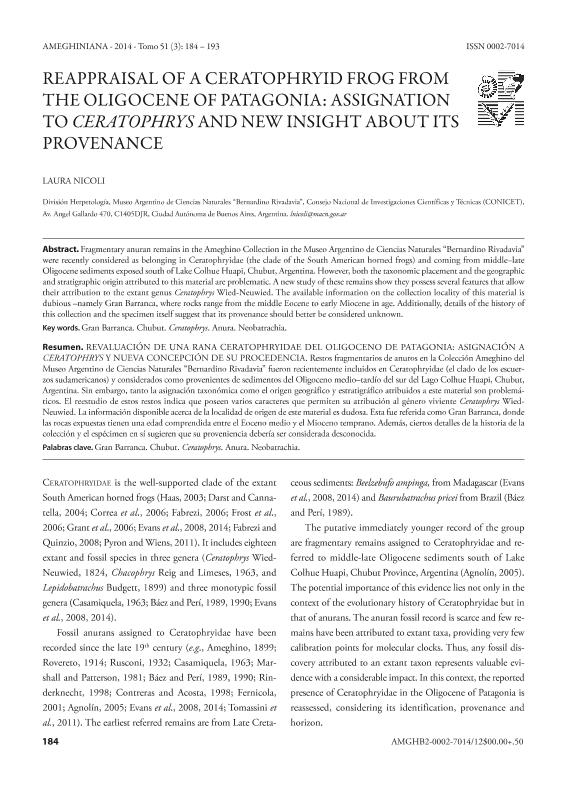Mostrar el registro sencillo del ítem
dc.contributor.author
Nicoli, Laura

dc.date.available
2016-12-12T21:28:13Z
dc.date.issued
2014-07
dc.identifier.citation
Nicoli, Laura; Reappraisal of a ceratophyid frog from the Oligocene of Patagonia: assignation to Ceratophrys and new insight about its provenance; Asociacion Paleontologica Argentina; Ameghiniana; 51; 3; 7-2014; 184-193
dc.identifier.issn
0002-7014
dc.identifier.uri
http://hdl.handle.net/11336/9203
dc.description.abstract
Fragmentary anuran remains in the Ameghino Collection in the Museo Argentino de Ciencias Naturales "Bernardino Rivadavia" were recently considered as belonging in Ceratophryidae (the clade of the South American horned frogs) and coming from middle-late Oligocene sediments exposed south of Lake Colhue Huapi, Chubut, Argentina. However, both the taxonomic placement and the geographic and stratigraphic origin attributed to this material are problematic. A new study of these remains show they possess several features that allow their attribution to the extant genus Ceratophrys Wied-Neuwied. The available information on the collection locality of this material is dubious namely Gran Barranca, where rocks range from the middle Eocene to early Miocene in age. Additionally, details of the history of this collection and the specimen itself suggest that its provenance should better be considered unknown.
dc.description.abstract
Restos fragmentarios de anuros en la Colección Ameghino del Museo Argentino de Ciencias Naturales “Bernardino Rivadavia” fueron recientemente incluidos en Ceratophryidae (el clado de los escuer- zos sudamericanos) y considerados como provenientes de sedimentos del Oligoceno medio–tardío del sur del Lago Colhue Huapi, Chubut, Argentina. Sin embargo, tanto la asignación taxonómica como el origen geográfico y estratigráfico atribuidos a este material son problemá- ticos. El reestudio de estos restos indica que poseen varios caracteres que permiten su atribución al género viviente Ceratophrys Wied- Neuwied. La información disponible acerca de la localidad de origen de este material es dudosa. Esta fue referida como Gran Barranca, donde las rocas expuestas tienen una edad comprendida entre el Eoceno medio y el Mioceno temprano. Además, ciertos detalles de la historia de la colección y el espécimen en sí sugieren que su proveniencia debería ser considerada desconocida.
dc.format
application/pdf
dc.language.iso
eng
dc.publisher
Asociacion Paleontologica Argentina

dc.rights
info:eu-repo/semantics/openAccess
dc.rights.uri
https://creativecommons.org/licenses/by-nc-sa/2.5/ar/
dc.subject
Gran Barranca
dc.subject
Chubut
dc.subject
Ceratophrys
dc.subject
Anura Neobatrachia
dc.subject.classification
Paleontología

dc.subject.classification
Ciencias de la Tierra y relacionadas con el Medio Ambiente

dc.subject.classification
CIENCIAS NATURALES Y EXACTAS

dc.title
Reappraisal of a ceratophyid frog from the Oligocene of Patagonia: assignation to Ceratophrys and new insight about its provenance
dc.title
Revaluación de una rana ceratophryidae del Oligoceno de Patagonia: asignación a ceratophrys y nueva concepción de su procedencia
dc.type
info:eu-repo/semantics/article
dc.type
info:ar-repo/semantics/artículo
dc.type
info:eu-repo/semantics/publishedVersion
dc.date.updated
2016-12-07T18:02:34Z
dc.identifier.eissn
1851-8044
dc.journal.volume
51
dc.journal.number
3
dc.journal.pagination
184-193
dc.journal.pais
Argentina

dc.journal.ciudad
Buenos Aires
dc.description.fil
Fil: Nicoli, Laura. Consejo Nacional de Investigaciones Científicas y Técnicas. Oficina de Coordinación Administrativa Parque Centenario. Museo Argentino de Ciencias Naturales; Argentina
dc.journal.title
Ameghiniana

dc.relation.alternativeid
info:eu-repo/semantics/altIdentifier/url/http://www.ameghiniana.org.ar/index.php/ameghiniana/article/view/1972
dc.relation.alternativeid
info:eu-repo/semantics/altIdentifier/doi/http://dx.doi.org/10.5710/AMGH.18.02.2014.1972
dc.relation.alternativeid
info:eu-repo/semantics/altIdentifier/url/http://www.bioone.org/doi/10.5710/AMGH.18.02.2014.1972?prevSearch=&
Archivos asociados
